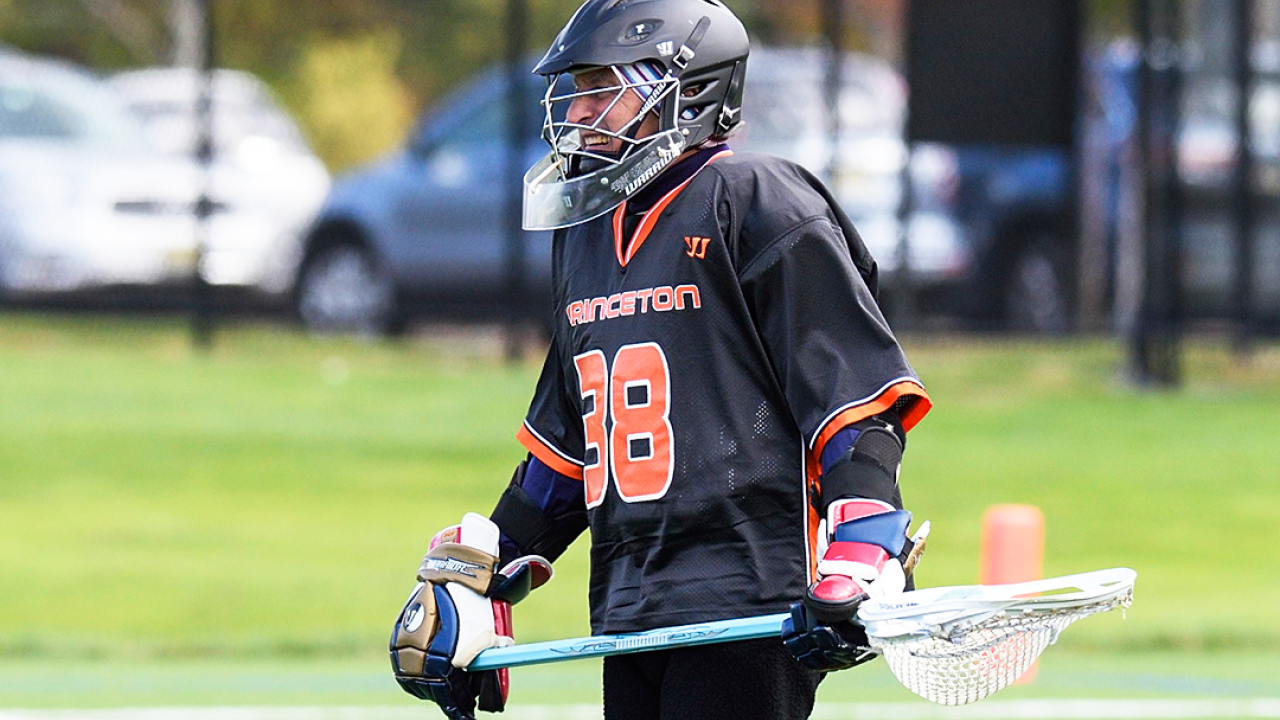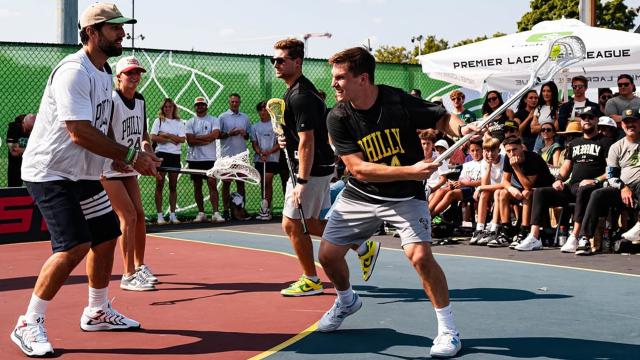
Cookie Krongard Still Playing Lacrosse at Age 80
Howard Krongard, more commonly known by his nickname “Cookie,” started playing lacrosse when he was 5 years old. He was a two-time All-American goalie at Princeton and named the outstanding player in the country twice. He’s been inducted into four halls of fame, including the National Lacrosse Hall of Fame in 1985 and the New York Sports Hall of Fame (he’s the only lacrosse player) in 1994.
But perhaps his most notable accomplishment is that Krongard still plays today at age 80. He’s a regular in the Florida Lacrosse League, where he faces blistering shots coming off the sticks of twenty-somethings, and competes annually in the Princeton alumni game.
According to one of his current teammates, attackman Reed Smith, Krongard is a humble man and a beast on the field.
“The way he stands in goal and faces competitive players week after week is a legendary accomplishment,” Smith said. “He is leading the way for adult lacrosse, whether he realizes it or not. We owe him a debt of gratitude.”
Growing up in Baltimore, Cookie was the little kid on the block. He literally followed in his brother Buzzy’s footsteps when the boys were young. One day, Buzzy removed little red knobs from beneath the legs of their mother’s breakfast table and put one on the end of his lacrosse stick.
“Naturally, I did the same,” Cookie Krongard said. “That was 75 years ago, and I’ve never played with a stick that didn’t have that same red knob on it. There’s nothing superstitious about it, but if I change sticks, I put the knob on it. I just like it.”
Krongard, an attorney who worked in the state department during President George W. Bush’s administration from 2005-08, found his lacrosse niche as a goalie and has played the position for more than 60 years. The Parkland, Fla., resident always looks for pickup games, scrimmages and tournaments.
“I challenge anyone to find a guy who has seen more rubber than Cookie,” said Todd Adler, an attackman from Cornell who plays with Krongard today. “His longevity is unparalleled in lacrosse, or any other sport.”
Another current teammate, attackman Bob Leland, agrees.
“When I first met Cookie, I was in shock and awe,” Leland said. “Not just because of his age, but because of his knowledge of the sport and how in tune he is with the lacrosse community. Everyone knows him.”
To say Krongard is one of the best goalies in history is an understatement. But you won’t hear him talk much about his accolades. In fact, Michael Sowers, the former Princeton attackman who now plays at Duke, had to hear from other people the legend of Cookie Krongard.
“It speaks to the type of person he is,” Sowers said. “He’s extremely humble. I cannot stress enough how much he has impacted me and the Princeton lacrosse program.”
GETTING STARTED
Krongard was not always a goalie. He played attack and then faced off as a midfielder. In those days, there was no such thing as a FOGO.
“My brother was one of the best faceoffs of all time,” Krongard said. “He was a faceoff guy, so I became a faceoff guy.”
Krongard’s high school team’s star goalie graduated at the end of his sophomore year. The coaches were looking for a new goalie and liked that Krongard was athletic and quick. He has been a goalie ever since then.
After high school, Krongard followed in his brother’s footsteps once again, this time to Princeton. He was a three-year starting goalie (1959-61) and led the Tigers to the Ivy League championship all three years. Playing against Cornell in 1960, Krongard made 20 saves and ran 70 yards to score a goal — rare for a goalie — to help Princeton clinch the Ivy League title. In fact, the Tigers never lost an Ivy League game with Krongard in goal. He was first-team All-Ivy League in 1960 and 1961, an honorable mention All-American in 1960 and a first-team All-American in 1961. His senior year, he was named outstanding goalie in the country.
“Lacrosse is a terrific game. It’s really who I am in a sense, in terms of commitment and dedication,” Krongard said. “It’s a lot like life. It’s teamwork, but it’s also individual drive, integrity — to the game and to your teammates — and loyalty.”
Krongard was a freshman at Princeton when his brother was a senior, but the two didn’t play together because at that time, freshmen weren’t eligible to play varsity. They finally got the chance in 1966 while playing with Mount Washington Club in Baltimore.
Buzzy Krongard, best known as the former executive director of the CIA and CEO of investment bank Alex. Brown & Sons, also is a member of the National Lacrosse Hall of Fame. They were the first brothers so honored. He was the captain of the first world champion U.S. national team in 1967.
Back then, before the NCAA, there was a national open championship where the best club teams played the best college teams. With the Krongards leading the way, Mount Washington beat Navy for the championship.
“It was the only game the great Jimmy Lewis lost,” Cookie Krongard said. “We beat him at Navy-Marine Corps Stadium in Annapolis.”

PHOTO COURTESY OF PRINCETON ATHLETICS
Krongard was a two-time All-American goalie at Princeton, notably making 20 saves and running the length of the field to score in a 1960 win over Cornell that clinched the Ivy League title.
Krongard’s favorite game, however, was that Princeton-Cornell tilt in 1960. There has always been a great lacrosse rivalry between the two schools and both teams were undefeated in the Ivy League that season. It was the last game of the year.
“I made a save in the opening quarter, dodged a bunch of guys and ran down the field and scored,” Krongard said. “It was the goal that stood up for a 6-5 win. I was the first goalie known to have run the length of the field and scored a goal, and it was the goal that won the Ivy League championship.”
Krongard’s 20th save of the game came with six seconds left. He denied Cornell’s All-American midfielder Dave Dresser to preserve the victory.
“That game has marked my career because I started it with a goal and finished it with a save,” Krongard said. “It was pretty good.”
Krongard went on to become an eight-time USCLA All-Star and two-time USCLA Player of the Year (1968 and 1974).
“He set a high bar for his performance and standard of excellence and he lived up to it,” said John Walters, who played against Krongard as an All-American and the country’s top scorer at Dartmouth and with him on the New York Lacrosse Club. “He always knew where the shot would be coming from and where it would end up. He has played at a high level for an extraordinary period of time.”
Bill Morton, a halfback in football and All-American in lacrosse at Dartmouth who also played for the New York Lacrosse Club, characterized Krongard as a natural athlete who also worked extremely hard.
“Cookie had an incredible knowledge and experience in the sport and he shared that with all of his teammates,” Morton said. “I benefitted from that and I will never forget it.”
GIVING BACK
Krongard went on to become vice president of the USCLA and director of the Lacrosse Foundation, a predecessor of US Lacrosse. He was named the USILA Man of the Year in 1983. But he never lost the desire to play. In 2008, he tried out for Major League Lacrosse — the outdoor pro league that recently merged with the Premier Lacrosse League — and was claimed by the New Jersey Pride.
“My friend, Princeton star and now Hall of Famer Jesse Hubbard, was playing for the Pride at the time and encouraged me to try out,” Krongard said. “As I told him, if I got hit by a shot like his, at least I would be the only player in the league with Medicare.”
It was no publicity stunt.
“I was very surprised in how he stepped in there and took the shots. He was getting knocks all over the place and stayed in,” said Rob Scherr, the Pride’s starting goalie at the time. “A lot of people don’t have the guys to even get in there at the level we do. But a 67-year-old guy coming in, that’s pretty interesting and pretty spectacular.”
Today, in addition to playing in club games in South Florida, Krongard also still plays in Princeton alumni varsity games.
“Cookie is a foundational member of our alumni games,” Tigers coach Matt Madalon said. “He brings an incredible perspective to the Princeton lacrosse world.”
Krongard works out with the Princeton team each fall the week prior to the alumni game. Madalon said he is a valuable resource and is impressed with his stewardship of the game.
“He has an incredible perspective and gives generously of his time, energy and resources,” Madalon said. “He is involved, thoughtful and engaged — including getting in the game and taking balls off the shin and body shots. He plays a big part in supporting the Long Orange Line.”
Beyond supporting the Princeton program and playing each week in Florida, Krongard also mentors young players. He talks to them about the importance of mental fortitue and the need to bounce back if you get scored on.
“Everyone in the stands sees it and it goes up on the scoreboard. There’s nothing you can do about that,” Krongard said. “You can’t still be thinking about that when the next one comes or it’s going to hit you in the throat. So you have to put that out of your mind, and that’s life.”
Playing with the mindset that he has to come back quickly every time a goal is scored on him has helped Krongard throughout his life.
“I’ve had a great life, but nothing is perfect. There are always downs to life that you have to come back from,” he said. “To me, lacrosse has really been a microcosm of life.”
Sowers called Krongard the godfather of Princeton lacrosse.
“It’s important for people to know how generous he is with his time,” Sowers said. “He told me I could turn to him for anything, and I have — as a student, a captain and for advice on my career.”
SOME THINGS DON’T CHANGE
Asked what makes a great lacrosse player, Krongard did not pretend to have an answer. But he acknowledged there are criteria on which most greats would agree.
“You’ve got to be committed. You’ve got to be willing to dig deep. You’ve got to be willing to run or play with pain,” he said. “I took one on the kneecap the other day and I would have liked to have sat down for a minute. But the ball was still in play, so I didn’t.”
Krongard has seen more shots as a goalie than anyone because no goalie has played as long as he has. He plays several times a week and loves the challenge of getting shot at.
“A lot of goalies love playing the game, but they’re not so keen on jumping in a goal,” he said. “I love getting in goal.”
Leland remembers playing in a game against Krongard and not shooting as hard as he normally would because of his age. During a break in the action, Krongard pulled Leland aside.
“He said to me, ‘What are you doing out there? Never let up on a shot. Give me your all, all the time,’” Leland said. “Cookie doesn’t want anyone to take it easy on him. A lot of younger kids are firing shots on him. He’s taking shots off his foot, his shins, his arms — he loves it. He stays on pipe and knows his line. He’s an exceptional goalie, regardless of his age.”
When Krongard started playing lacrosse in 1946, he used a heavy wooden stick, then plastic and today titanium. Equipment and protective pads have gotten better and lighter. Players’ conditioning is better — guys are in the weight room, running and working out all year long.
“All those things have changed, but the goal is still 6-by-6,” Krongard said. “The ball is still as round as it always was, the same size, more or less the same ball.”
The more things change, Krongard said, the more they stay the same. You still have to keep the ball out of the goal, run faster than your opponent and be willing to hit a little harder and scoop a little better.
Krongard said the equipment technology and training have changed the most, and the coaching is better. When he was younger, there would be one coach per team.
“Today you might have as many as seven coaches on a team — offense, defense and clearing, faceoff, an extra man, a man down,” Krongard said. “Obviously the game has exploded.”
A MEANINGFUL SPORT
Krongard hopes today’s high school and college lacrosse players understand the sport’s roots and its history, honor the game and realize the difference between it and other sports.
“Lacrosse has a lot of meaning to it and that’s what I’d like people to know more about,” he said. “It is the Native Americans’ game. Just about every tribe around the country has a form of lacrosse. They don’t all play the kind of field lacrosse with the same equipment we do, but lacrosse as a concept has such meaning to all Native Americans.”
Many of Krongard’s teammates over the years have been Native American, including his close friend, Hall of Famer and Syracuse All-American goalie Chief Oren Lyons, with whom he played on the New York Lacrosse Club. As a result, Krongard is very involved in Native American activities and has spent time on reservations working with lacrosse.
“Oren is a leading spokesman in the world for Indigenous peoples,” Krongard said of Lyons, faithkeeper of the Wolf Clan of the Seneca Nation of the Haudenosaunee Confederacy. “He was instrumental in helping me understand that I could do things for them — not just be friends or teammates with them.”
Krongard is a mentor and financial supporter of Native Vision, a national youth enrichment and empowerment initiative for Native American children, operated by the Johns Hopkins Center for American Indian Health.
“It’s a wonderful program that uses sports to bring Native American boys and girls together to learn,” Krongard said. “We start by teaching them about sports, but we also get into nutrition, honoring women, drug and alcohol abuse and suicide prevention.”
Krongard has been a generous charitable donor to Native Vision for many years, in addition to volunteering as a lacrosse coach and mentor. At the end of 2019, he announced that he would match all new charitable donations to Native Vision up to $25,000. It resulted in an infusion of funds from 30 people across the country.
“Cookie is a great role model to all of us — kids, coaches and administrative staff,” said Allison Barlow, director at the Johns Hopkins Center for American Indian Health. “He is devoted to the kids and the program and he works tirelessly to ensure that people know lacrosse was originally a Native American game. We’re so grateful for that on behalf of Native American peoples.”
STILL GOING STRONG
There is one record Krongard is proud of that will never be matched or broken. He was named the USCLA’s most outstanding player in 1968 using a wooden stick and in 1974 using a plastic stick. It was never done by anyone else and can’t be, he said, since wooden sticks are a part of history.
Krongard has played at Cambridge University. He lived in Paris in the early 1970s and commuted to London to play for a team in England during that time. He has played masters (35-and-older) world championships in Australia, England and the U.S. The red knob he started using when he was 5 years old has been all over the world.
Krongard, who celebrated his 80th birthday in December, has never played against anyone older than him in recent years. His eyes aren’t as good as they used to be. His reflexes and foot speed aren’t as quick. But his technique gets better every time he plays, he said.
“It keeps me young,” Krongard said. “I work hard. My ego is big enough that I don’t want to embarrass myself or get scored on, so that drives me to keep in shape at my age.”
Seventy-five years after he first started playing lacrosse, Cookie still gets annoyed by every goal scored on him.
“I wasn’t all that satisfied with my performance today,” Krongard said when interviewed for this story. “Everyone thought I played great, but I know I can play better.”
Michelle Booth
Related Articles





